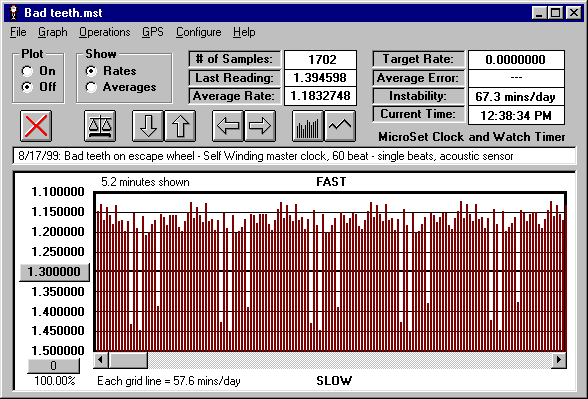Using MicroSet and the computer interface, it’s possible to dramatically show flaws in the escapement. The graph below shows the behavior of a Self Winding clock with a one second pendulum.

Each bar in this graph represents one pallet striking each escape wheel tooth. Such readings are possible by setting MicroSet to report the time of one beat and using the acoustic sensor. With this setting, MicroSet will skip every other beat and report just the “odd” or “even” beats. This means it measures the striking of the same pallet on each subsequent escape wheel tooth.
Looking at this graph, you will see that there is a distinct repeating pattern. This pattern repeats with every rotation of the escape wheel. Counting bars, we can see that the escape wheel has 30 teeth. Most of the bars are tall, but there is a recurring sequence of three bars that are much lower. These are caused by some flaw in the escapement. This could be deformed escape wheel teeth or flaws in the escape wheel pinion. By examining the values shown at the left edge of the graph, we can even see that these beats are slow by about .25 seconds. To identify which teeth are causing the problem it’s helpful to have another person watch the computer screen and tell you when the bad tooth is coming up, while you watch the escape wheel.
This graph also shows us something else about this movement. It’s badly out of beat. Notice that the beat times are mostly about 1.2 seconds long. Since this is a one second pendulum, the beats are all too long. The beats we are not reading (the other half) will all be short enough to make the total beat time equal to one second. They will be about .8 seconds long. So this movement is out of beat in the ratio of 3:2.
